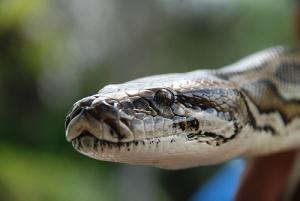
According to research published in the Proceedings of the National Academy of Sciences (PNAS), the invasive species, the Burmese python (Python molurus bivittatus), is the cause of a devastating decline in mammals found in the Everglades, Florida.
Currently, there are no valid estimates for the population density of the Burmese python, but the number caught each year is on the increase. They are thought to have originated in the Everglades due to pet owners being unable to cope with such a large snake at home and consequently, releasing them into the wild.
Data collected in the 1990’s of road kill and live and dead animals seen on surveys, were compared with data collected (using a similar method) between 2003 – 2011. On average the snakes measured approximately 12 feet long! Due to their large size, they are capable of preying upon some of the Everglade’s endangered species such as, the Key Largo woodrat (Neotoma floridana smalli), listed as Endangered by the IUCN Red List and the American alligator (Alligator mississippiensis), listed as Vulnerable.
Results from this research indicate that the Burmese python is the cause of a dramatic drop in the populations of native mammals found in the Everglades. Bobcat (Lynx rufus) sightings were down by 87.5%, white-tailed deer (Odocoileus virginianus) by 94.1%, Virginia opossums (Didelphis virginiana) by 98.9%, raccoons (Procyon lotor) by 98.9% and marsh rabbits were not recorded at all! Sightings of these, and other mammals were also more common in the areas where the Burmese python has not been present for very long.
It is also important to note that the introduction of a top predator that should not be there, may be affecting the whole food chain found within the Everglades. For example, the larger mammals such as the bobcat have probably been displaced to other habitats due their prey, marsh rabbits, disappearing, rather than the Burmese python developing a sudden taste for bobcats.
The U.S. federal government is obviously very keen to try and reverse the affects of unwanted pets released into the Everglades. Importation and sale of the Burmese python, the yellow anaconda (Eunectes notaeus) and two subspecies of the African python (Python sebae), are now banned.
Hopefully, this research has highlighted the significant effect an invasive species can have on a highly important ecosystem such as the Everglades and action can be taken to preserve it and prevent similar situations arising in the future.
By Haley Dolton
Advertisement
